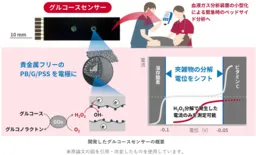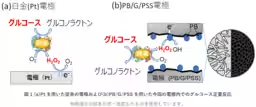

Revolutionary Non-PGM Glucose Sensor Developed for Blood Sugar Measurement
Innovative Glucose Sensor Breakthrough
Researchers at the National Institute of Advanced Industrial Science and Technology (AIST), in collaboration with Technomedica and Tohoku University, have pioneered a groundbreaking glucose sensor that operates without the use of precious metals. This innovation is especially significant in the context of blood gas analysis equipment, which is essential for emergency medical care. By using a novel electrode design that includes a porous silica sphere coated with graphene and functionalized with Prussian Blue (PB), this sensor can measure glucose concentrations in blood without interference from compounds like dissolved oxygen and vitamin C.
Key Features of the Sensor
Replacement of Traditional Electrodes
The newly developed glucose sensor utilizes PB/G/PSS electrodes to replace conventional platinum electrodes. This is crucial because the detection mechanisms of existing sensors are often confounded by the electrochemical activity of surrounding substances within blood, particularly as they tend to share similar decomposition potentials with hydrogen peroxide (H₂O₂), the key molecule generated during glucose oxidation.
Simplification of Structure
A substantial advantage of the new sensor design is its structural simplicity, which contributes to the miniaturization and cost-effectiveness of blood gas analysis devices. The ability to measure glucose accurately over a wide concentration range (0 to 270 mg/dL, including the normal fasting range of 70 to 100 mg/dL) makes it a versatile tool for healthcare professionals.
The Importance of Accurate Blood Glucose Measurement
In an emergency care setting, rapid assessment of a patient's condition is crucial. The ability to simultaneously monitor glucose levels alongside oxygen and carbon dioxide helps clinicians address potential crises efficiently. However, the need for small, portable devices has increased as such instrumentation traditionally relied on larger setups that require arterial blood, which places a burden on patients, particularly in pediatric cases.
Novel Approach to Electrochemical Sensing
This new glucose sensor operates by shifting the decomposition potentials of H₂O₂, oxygen, and vitamin C to create what scientists refer to as an 'electrochemical window.' This feature allows the sensor to effectively distinguish glucose levels without the need for elaborate removal mechanisms for potential interfering substances.
The PB/G/PSS electrode is designed to catalyze the electrochemical reactions necessary for glucose sensing while minimizing the effects of surrounding chemical compounds. With its environmentally sustainable, noble-metal-free structure, this sensor not only reduces manufacturing costs but also supports environmentally friendly practices in medical technology.
Anticipated Applications and Future Prospects
Looking forward, the research team aims to expand this technology's usability by integrating it into comprehensive blood gas analyzers. The adaptation of this sensor technology could lead to improved point-of-care testing and monitoring systems, thus enhancing patient quality of life through rapid and accurate diagnostics.
This breakthrough is set to be documented in detail in the upcoming issue of ACS Electrochemistry on May 12, 2025. The ease of manufacturing and stable supply of non-precious metal materials positions this technology as a promising advancement in the fields of biomedical engineering and clinical diagnostics.
Summary
Overall, the development of this non-PGM glucose sensor represents a significant step forward in blood analysis technology. By addressing the common challenges associated with traditional sensors, this innovation not only paves the way for more convenient and efficient blood testing but also aligns with a sustainable future in medical technologies.
For further reading on the research and its implications, please refer to the original press release on the AIST website: AIST Press Release.




Topics Health)










【About Using Articles】
You can freely use the title and article content by linking to the page where the article is posted.
※ Images cannot be used.
【About Links】
Links are free to use.